A Fiber-Coupled Quartz-Enhanced Photoacoustic Sensor for Dissolved Gas Detection
Abstract
1. Introduction
2. Materials and Methods
3. Sensor Configuration and Experimental Setup
3.1. Fiber-Coupled Spectrophone
3.2. Experimental Setup
4. Experimental Results and Discussion
4.1. System Parameter Optimization
4.2. Sensor Performance
4.3. In situ Detection of Deep-Sea Dissolved CH4
5. Conclusions
Author Contributions
Funding
Institutional Review Board Statement
Informed Consent Statement
Data Availability Statement
Conflicts of Interest
References
- Falkowski, P.; Scholes, R.J.; Boyle, E.; Canadell, J.; Canfield, D.; Elser, J.; Gruber, N.; Hibbard, K.; Högberg, P.; Linder, S.; et al. The global carbon cycle: A test of our knowledge of earth as a system. Science 2000, 290, 291–296. [Google Scholar] [CrossRef]
- Reeburgh, W.S. Oceanic methane biogeochemistry. Chem. Rev. 2007, 107, 486–513. [Google Scholar] [CrossRef] [PubMed]
- Roberts, H.H.; Aharon, P. Hydrocarbon-derived carbonate buildups of the northern Gulf of Mexico continental slope: A review of submersible investigations. Geo-Mar. Lett 1994, 14, 135–148. [Google Scholar] [CrossRef]
- Wankel, S.D.; Germanovich, L.N.; Lilley, M.D.; Gence, G.; Christopher, J.D.; Alexander, S.B.; Eric, J.O.; Peter, R.G. Influence of subsurface biosphere on geochemical fluxes from diffuse hydrothermal fluids. Nat. Geosci. 2011, 4, 461–468. [Google Scholar] [CrossRef]
- Martens, C.S.; Blair, N.E.; Green, C.D.; Marais, D.J. Seasonal variations in the stable carbon isotopic signature of biogenic methane in a coastal sediment. Science 1986, 233, 1300–1303. [Google Scholar] [CrossRef] [PubMed]
- Friedlingstein, P.; Cox, P.; Betts, R.; Bopp, L.; von Bloh, W.; Brovkin, V.; Cadule, P.; Doney, S.; Eby, M.; Fung, I.; et al. Climate–carbon cycle feedback analysis: Results from the C4MIP model intercomparison. J. Clim. 2006, 19, 3337–3353. [Google Scholar] [CrossRef]
- Butler, J.H.; Elkins, J.W. An automated technique for the measurement of dissolved N2O in natural waters. Mar. Chem. 1991, 34, 47–61. [Google Scholar] [CrossRef]
- Cai, M.; Huang, P.; Zhang, M.; Li, W. A Purge and Trap Gas Chromatographic Method for Detection of Chlorofluorocarbons in Seawater. Chin. J. Anal. Chem. 2013, 41, 268–272. [Google Scholar] [CrossRef]
- Zhang, H.; Li, J.; Yang, G.; Song, Y.; Jin, N. Purge- trap Gas Chromatography and Mass Spectrometric Method for Analysis of Isoprene in Natural Waters. Chin. J. Anal. Chem. 2015, 43, 333–337. [Google Scholar] [CrossRef]
- Grilli, R.; Darchambeau, F.; Chappellaz, J.; Mugisha, A.; Triest, J.; Umutoni, A. Continuous in situ measurement of dissolved methane in Lake Kivu using a membrane inlet laser spectrometer. Geosci. Instrum. Methods Data Syst. 2020, 9, 141–151. [Google Scholar] [CrossRef]
- Zhang, X.; Du, Z.; Zheng, R.; Luan, Z.; Qi, F.; Cheng, K.; Wang, B.; Ye, W.; Liu, X.; Lian, C.; et al. Development of a new deep-sea hybrid Raman insertion probe and its application to the geochemistry of hydrothermal vent and cold seep fluids. Deep. Sea Res. Part I Oceanogr. Res. Pap. 2017, 123, 1–12. [Google Scholar] [CrossRef]
- Watson, J.; Payne, P. A study of organic compound pervaporation through silicone rubber. J. Membr. Sci. 1990, 49, 171–205. [Google Scholar] [CrossRef]
- Lv, Y.; Huang, K.; Zhang, W.; Ran, S.; Chi, F.; Yang, B.; Liu, X. High-performance gas-sensing properties of octahedral NiO crystals prepared via one-step controllable synthesis route. Cryst. Res. Technol. 2014, 49, 109–115. [Google Scholar] [CrossRef]
- Domon, B.; Aebersold, R. Mass Spectrometry and Protein Analysis. Science 2006, 312, 212–217. [Google Scholar] [CrossRef]
- Zheng, K.; Zheng, C.; Zhang, H.; Guan, G.; Zhang, Y.; Wang, Y.; Tittel, F.K. A novel gas sensing scheme using near-infrared multi-input multi-output off-axis integrated cavity output spectroscopy (MIMO-OA-ICOS). Spectrochim. Acta Part A Mol. Biomol. Spectrosc. 2021, 256, 119745. [Google Scholar] [CrossRef]
- Tan, X.; Zhang, H.; Li, J.; Wan, H.; Guo, Q.; Zhu, H.; Liu, H.; Yi, F. Non-dispersive infrared multi-gas sensing via nanoantenna integrated narrowband detectors. Nat. Commun 2020, 11, 5245. [Google Scholar] [CrossRef]
- Vallon, R.; Soutade, J.; Vérant, J.-L.; Meyers, J.; Paris, S.; Mohamed, A. A Compact Tunable Diode Laser Absorption Spectrometer to Monitor CO2 at 2.7 µm Wavelength in Hypersonic Flows. Sensors 2010, 10, 6081–6091. [Google Scholar] [CrossRef]
- Wankel, S.D.; Huang, Y.-W.; Gupta, M.; Provencal, R.; Leen, J.B.; Fahrland, A.; Vidoudez, C.; Girguis, P.R. Characterizing the Distribution of Methane Sources and Cycling in the Deep Sea via in Situ Stable Isotope Analysis. Environ. Sci. Technol. 2012, 47, 1478–1486. [Google Scholar] [CrossRef]
- Mohtada, S.; Mohammad, A.; Kazem, S.; Toraj, M. Gas permeation through a synthesized composite PDMS/PES membrane. J. Membr. 2009, 342, 236–250. [Google Scholar]
- Wu, H.; Dong, L.; Zheng, H.; Yu, Y.; Ma, W.; Zhang, L.; Yin, W.; Xiao, L.; Jia, S.; Tittel, F.K. Beat frequency quartz-enhanced photoacoustic spectroscopy for fast and calibration-free continuous trace-gas monitoring. Nat. Commun. 2017, 8, 15331. [Google Scholar] [CrossRef]
- Wei, T.; Zifarelli, A.; Russo, S.D.; Wu, H.; Menduni, G.; Patimisco, P.; Sampaolo, A.; Spagnolo, V.; Dong, L. High and flat spectral responsivity of quartz tuning fork used as infrared photodetector in tunable diode laser spectroscopy. Appl. Phys. Rev. 2021, 8, 041409. [Google Scholar] [CrossRef]
- Yin, X.; Dong, L.; Wu, H.; Gao, M.; Zhang, L.; Zhang, X.; Liu, L.; Shao, X.; Tittel, F.K. Compact QEPAS humidity sensor in SF6 buffer gas for high-voltage gas power systems. Photoacoustics 2021, 25, 100319. [Google Scholar] [CrossRef] [PubMed]
- Ma, Y.; Hu, Y.; Qiao, S.; Lang, Z.; Liu, X.; He, Y.; Spagnolo, V. Quartz tuning forks resonance frequency matching for laser spectroscopy sensing. Photoacoustics 2022, 25, 100329. [Google Scholar] [CrossRef] [PubMed]
- Zhang, Q.; Chang, J.; Wang, Q.; Wang, Z.; Wang, F.; Qin, Z. Acousto-Optic Q-Switched Fiber Laser-Based Intra-Cavity Photoacoustic Spectroscopy for Trace Gas Detection. Sensors 2018, 18, 42. [Google Scholar] [CrossRef] [PubMed]
- Li, M.; Hu, M.; Zhang, H.; Wang, J.; Tang, T.; Hu, M.; Wang, Q. All-Fiber Photoacoustic Gas Sensing with Interferometric Location. Photonics 2022, 9, 546. [Google Scholar] [CrossRef]
- Zhang, Q.; Chang, J.; Cong, Z.; Sun, J.; Wang, Z. QEPAS sensor for simultaneous measurements of H2O, CH4, and C2H2 using different QTFs. IEEE Photon. J. 2018, 10, 1–8. [Google Scholar] [CrossRef]
- Kosterev, A.A.; Bakhirkin, Y.A.; Curl, R.F.; Tittel, F.K. Quartz-enhanced photoacoustic spectroscopy. Opt. Lett. 2002, 27, 1902–1904. [Google Scholar] [CrossRef]
- Wang, F.; Cheng, Y.; Xue, Q.; Wang, Q.; Liang, R.; Wu, J.; Sun, J.; Zhu, C.; Li, Q. Techniques to enhance the photoacoustic signal for trace gas sensing: A review. Sens. Actuator A Phys. 2022, 345, 113807. [Google Scholar] [CrossRef]
- Borri, S.; Patimisco, P.; Galli, I.; Mazzotti, D.; Giusfredi, G.; Akikusa, N.; Yamanishi, M.; Scamarcio, G.; De Natale, P.; Spagnolo, V. Intracavity quartz-enhanced photoacoustic sensor. Appl. Phys. Lett. 2014, 104, 091114. [Google Scholar] [CrossRef]
- Sampaolo, A.; Csutak, S.; Patimisco, P.; Giglio, M.; Menduni, G.; Passaro, V.; Tittel, F.K.; Deffenbaugh, M.; Spagnolo, V. Methane, ethane and propane detection using a compact quartz enhanced photoacoustic sensor and a single interband cascade laser. Sens. Actuators B Chem. 2018, 282, 952–960. [Google Scholar] [CrossRef]
- Wang, Z.; Wang, Q.; Zhang, H.; Borri, S.; Galli, I.; Sampaolo, A.; Patimisco, P.; Spagnolo, V.L.; De Natale, P.; Ren, W. Doubly resonant sub-ppt photoacoustic gas detection with eight decades dynamic range. Photoacoustics 2022, 27, 100387. [Google Scholar] [CrossRef]
- Zhang, H.; Wang, Z.; Wang, Q.; Borri, S.; Galli, I.; Sampaolo, A.; Patimisco, P.; Spagnolo, V.L.; Natale, P.D.; Ren, W. Parts-per-billion-level detection of hydrogen sulfide based on doubly resonant photoacoustic spectroscopy with line-locking. Photoacoustics 2023, 29, 100436. [Google Scholar] [CrossRef]
- Wang, F.; Chang, J.; Wang, Q.; Liu, Y.; Liu, Z.; Qin, Z.; Zhu, C. Improvement in QEPAS system based on miniaturized collimator and flat mirror. Opt. Commun. 2016, 381, 152–157. [Google Scholar] [CrossRef]
- Kosterev, A.A.; Tittel, F.K.; Serebryakov, D.V.; Malinovsky, A.L.; Morozov, I.V. Applications of quartz tuning forks in spectroscopic gas sensing. Rev. Sci. Instrum. 2005, 76, 043105. [Google Scholar] [CrossRef]
- Liu, K.; Li, J.; Wang, L.; Tan, T.; Zhang, W.; Gao, X.; Chen, W.; Tittel, F.K. Trace gas sensor based on quartz tuning fork enhanced laser photoacoustic spectroscopy. Appl. Phys. B Laser Opt. 2009, 94, 527–533. [Google Scholar] [CrossRef]
- Dong, Y.; Chen, J.; Luo, L.; Forsberg, E.; He, S.; Yan, C. Modeling and implementation of a fiber-based quartz-enhanced photoacoustic spectroscopy system. Appl. Opt. 2015, 54, 4202–4206. [Google Scholar] [CrossRef]
- Ma, Y.; He, Y.; Yu, X.; Zhang, J.; Sun, R.; Tittel, F.K. Compact all-fiber quartz-enhanced photoacoustic spectroscopy sensor with a 30.72 kHz quartz tuning fork and spatially resolved trace gas detection. Appl. Phys. Lett. 2016, 108, 091115. [Google Scholar] [CrossRef]
- Lewicki, R.; Wysocki, G.; Kosterev, A.A.; Tittel, F.K. QEPAS based detection of broadband absorbing molecules using a widely tunable, cw quantum cascade laser at 8.4 μm. Opt. Express 2007, 15, 7357–7366. [Google Scholar] [CrossRef]
- Liu, K.; Yi, H.; Kosterev, A.A.; Chen, W.; Dong, L.; Wang, L.; Tan, T.; Zhang, W.; Tittel, F.K.; Gao, X. Trace gas detection based on off-beam quartz enhanced photoacoustic spectroscopy: Optimization and performance evaluation. Rev. Sci. Instrum. 2010, 81, 103103. [Google Scholar] [CrossRef]
- Yi, H.; Chen, W.; Guo, X.; Sun, S.; Liu, K.; Tan, T.; Zhang, W.; Gao, X. An acoustic model for microresonator in on-beam quartz-enhanced photoacoustic spectroscopy. Appl. Phys. B Laser Opt. 2012, 108, 361–367. [Google Scholar] [CrossRef]
- Qiao, S.; He, Y.; Ma, Y. Trace gas sensing based on single-quartz-enhanced photoacoustic–photothermal dual spectroscopy. Opt. Lett. 2021, 46, 2449–2452. [Google Scholar] [CrossRef] [PubMed]
- Cao, Y.; Jin, W.; Ho, H.L.; Qi, L.; Yang, Y.H. Acetylene detection based on diode laser QEPAS: Combined wavelength and residual amplitude modulation. Appl. Phys. B Laser Opt. 2012, 109, 359–366. [Google Scholar] [CrossRef]
- Lin, C.; Zhu, Y.; Wei, W.; Wang, N.; Bao, W. A Novel QEPAS with Microresonator in the Open Environment. Int. J. Thermophys. 2012, 34, 1413–1420. [Google Scholar] [CrossRef]
- Rahimi, M.; Chae, I.; Hawk, J.E.; Mitra, S.K.; Thundat, T. Methane sensing at room temperature using photothermal cantilever deflection spectroscopy. Sens. Actuators B Chem. 2015, 221, 564–569. [Google Scholar] [CrossRef]
- Sgobba, F.; Menduni, G.; Russo, S.D.; Sampaolo, A.; Patimisco, P.; Giglio, M.; Ranieri, E.; Passaro, V.M.N.; Tittel, F.K.; Spagnolo, V. Quartz-Enhanced Photoacoustic Detection of Ethane in the Near-IR Exploiting a Highly Performant Spectrophone. Appl. Sci. 2020, 10, 2447. [Google Scholar] [CrossRef]
- Hu, M.; Chen, B.; Yao, L.; Yang, C.; Chen, X.; Kan, R. A Fiber-Integrated CRDS Sensor for In-Situ Measurement of Dissolved Carbon Dioxide in Seawater. Sensors 2021, 21, 6436. [Google Scholar] [CrossRef]
- Feng, J.; Yang, S.; Wang, H.; Liang, J.; Fang, Y.; Luo, M. Methane Source and Turnover in the Shallow Sediments to the West of Haima Cold Seeps on the Northwestern Slope of the South China Sea. Geofluids 2019, 2019, 18. [Google Scholar] [CrossRef]
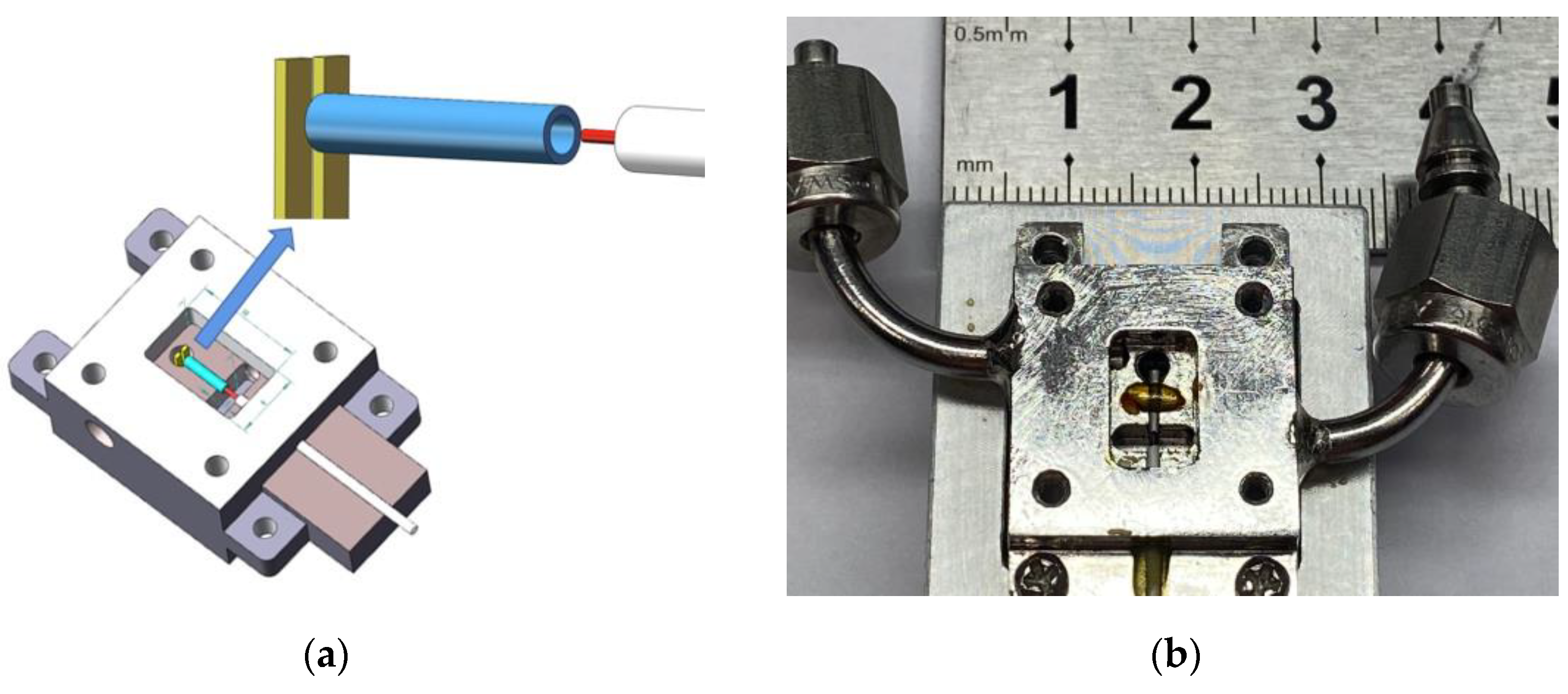

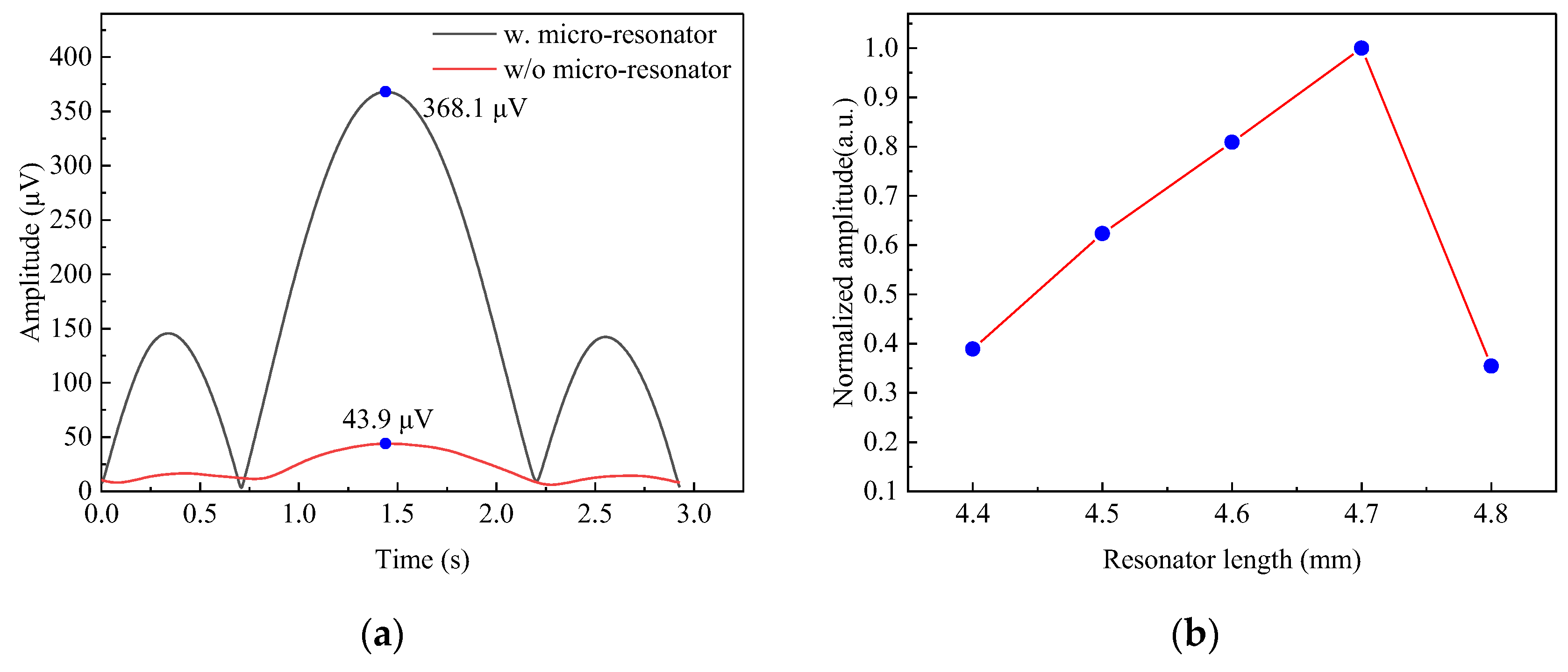

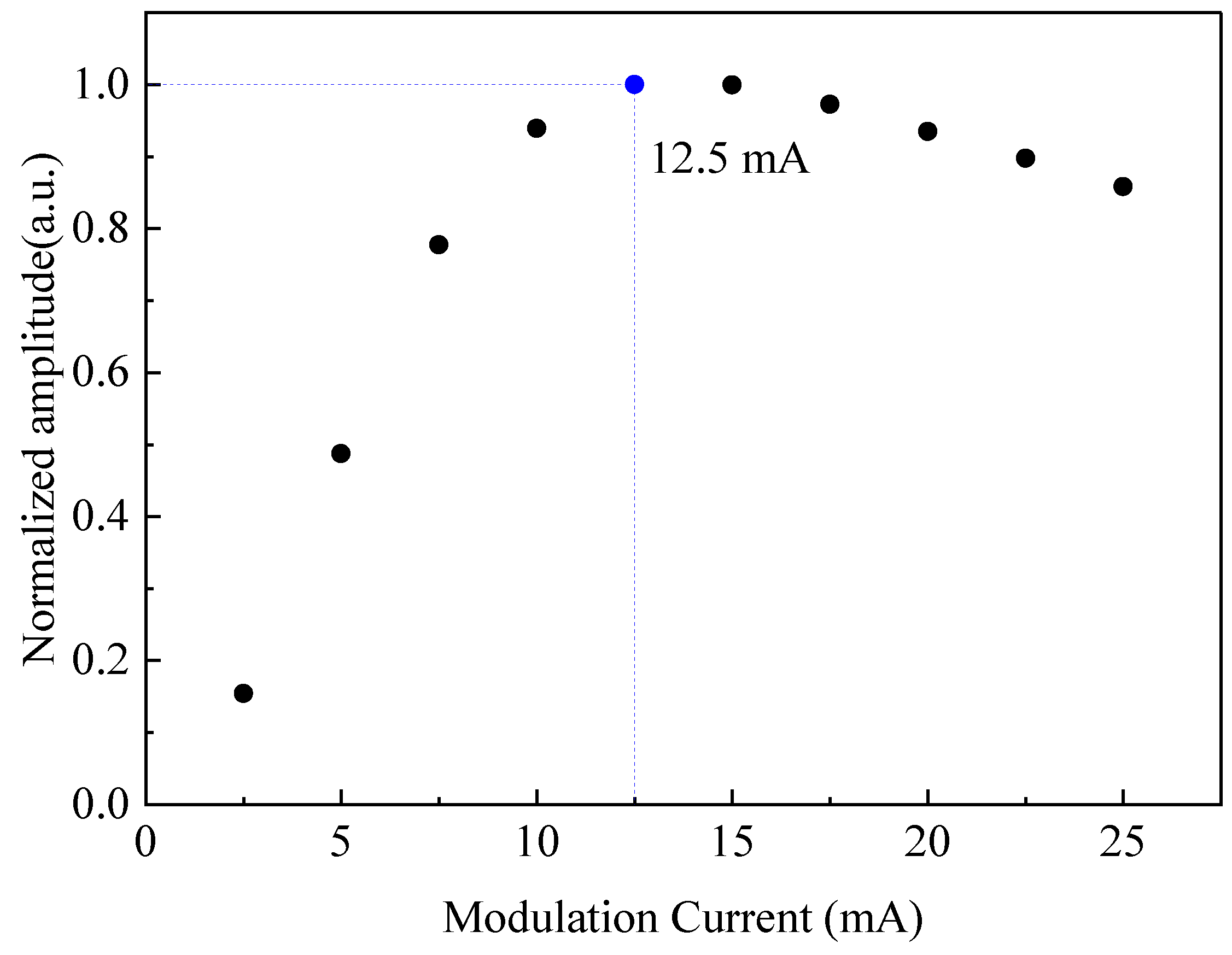
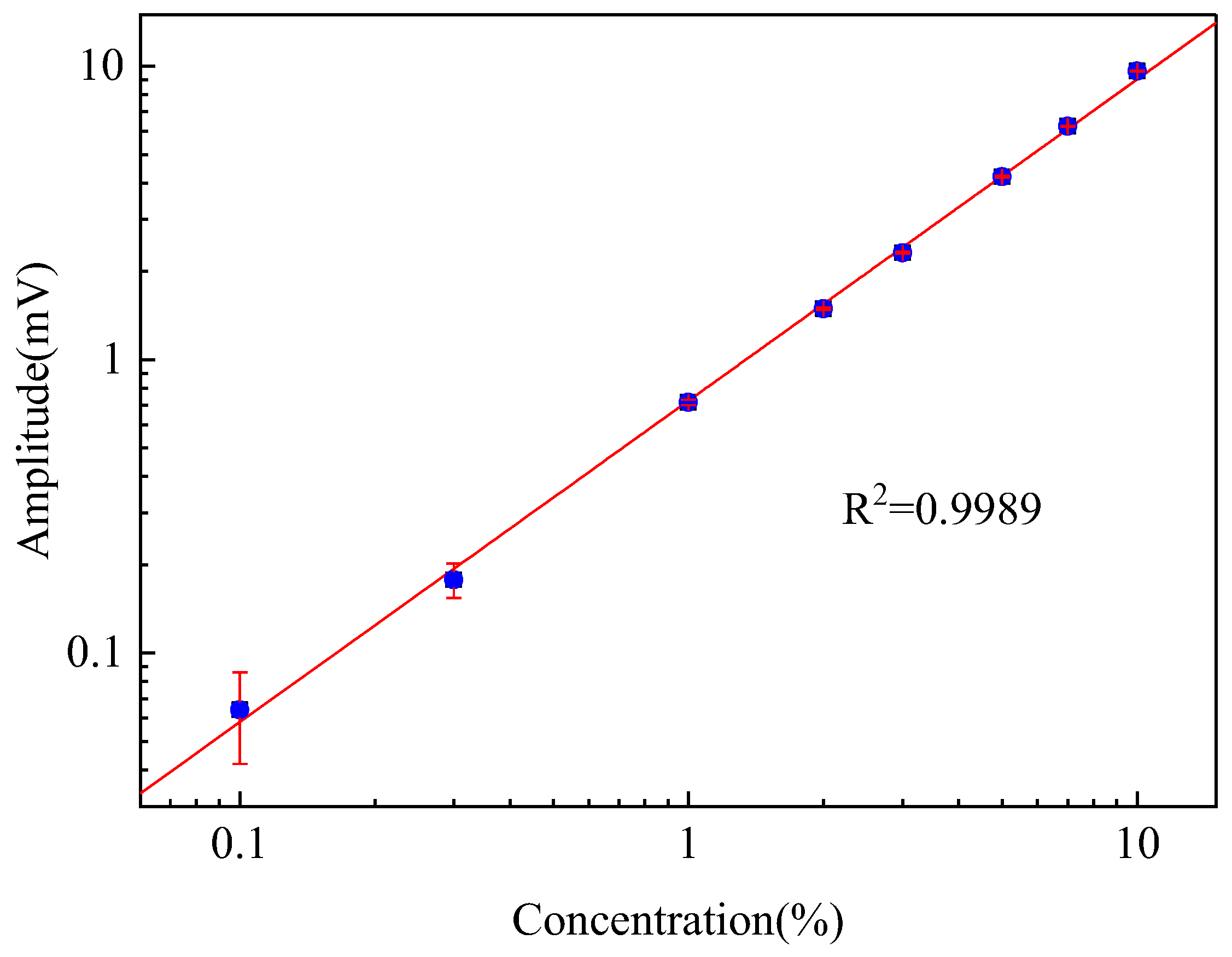

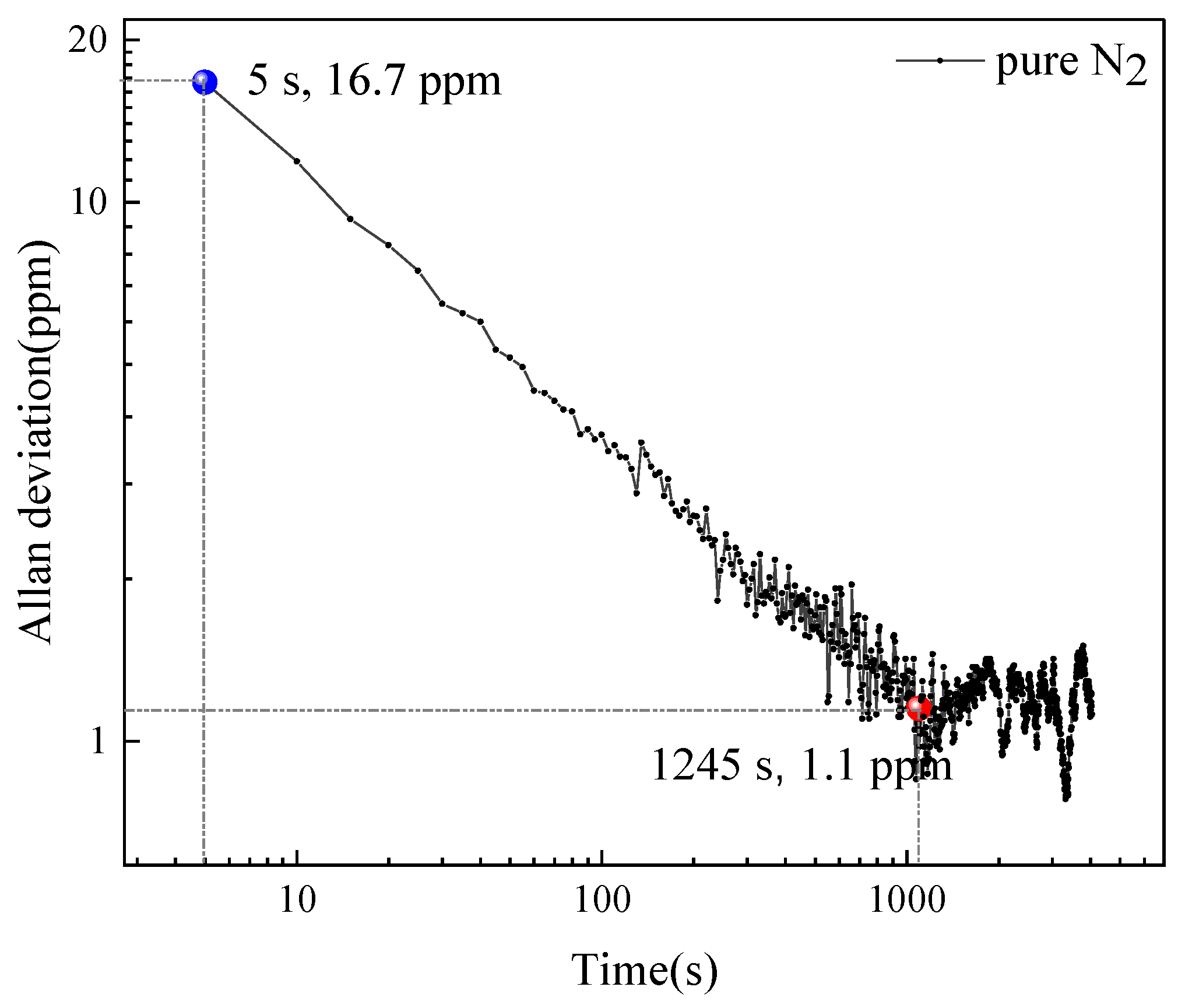

Disclaimer/Publisher’s Note: The statements, opinions and data contained in all publications are solely those of the individual author(s) and contributor(s) and not of MDPI and/or the editor(s). MDPI and/or the editor(s) disclaim responsibility for any injury to people or property resulting from any ideas, methods, instructions or products referred to in the content. |
© 2023 by the authors. Licensee MDPI, Basel, Switzerland. This article is an open access article distributed under the terms and conditions of the Creative Commons Attribution (CC BY) license (https://creativecommons.org/licenses/by/4.0/).
Share and Cite
Zhao, H.; Zhang, H.; Hu, M.; Hu, M.; Zhou, Y.; Liang, J.; Wang, Q. A Fiber-Coupled Quartz-Enhanced Photoacoustic Sensor for Dissolved Gas Detection. Photonics 2023, 10, 127. https://doi.org/10.3390/photonics10020127
Zhao H, Zhang H, Hu M, Hu M, Zhou Y, Liang J, Wang Q. A Fiber-Coupled Quartz-Enhanced Photoacoustic Sensor for Dissolved Gas Detection. Photonics. 2023; 10(2):127. https://doi.org/10.3390/photonics10020127
Chicago/Turabian StyleZhao, Huiyuan, Hui Zhang, Mengpeng Hu, Mai Hu, Yan Zhou, Jingqiu Liang, and Qiang Wang. 2023. "A Fiber-Coupled Quartz-Enhanced Photoacoustic Sensor for Dissolved Gas Detection" Photonics 10, no. 2: 127. https://doi.org/10.3390/photonics10020127
APA StyleZhao, H., Zhang, H., Hu, M., Hu, M., Zhou, Y., Liang, J., & Wang, Q. (2023). A Fiber-Coupled Quartz-Enhanced Photoacoustic Sensor for Dissolved Gas Detection. Photonics, 10(2), 127. https://doi.org/10.3390/photonics10020127





